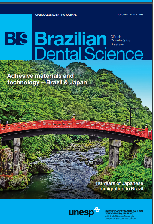Effect of beverages with different alcoholic concentration on composite resins
DOI:
https://doi.org/10.14295/bds.2018.v21i2.1516Abstract
Objective: To evaluate if alcoholic beverages can cause color change in composite resins, if the alcoholic concentration influences this variation besides analyzing within the composite resins tested, which would present greater color stability when subjected to the experiment. Material and Methods: 90 specimens of three different composite resins (IPS Empress Direct, Grandio®So and Filtek Z350 XT) were immersed in distilled water (control group), red wine and vodka. The samples were 2 mm thick and 8 mm in diameter, photopolymerized for 20 s on each side, polished with sandpaper, silicon carbide tip and felt disc with prophylactic paste and immersed in distilled water at 37 °C for 24 h prior to subgrouping. For the evaluation of the color variation, the formula prioritized by the CIEL *a *b* system was used. Data were analyzed by ANOVA and Tukey’s test at 95% significance. Results: The lowest variations occurred with the Grandio®So resin when exposed to wine, and Filtek Z350 XT when exposed to vodka. There was a statistically significant difference between the groups in water (p < 0.01) and in red wine (p < 0.01), but not in vodka (p > 0.05). The soaking medium that most caused staining was red wine. Conclusion: Red wine was the drink that generated the highest staining in all the resins tested, vodka did not change color stability significantly, the alcoholic concentrations tested did not directly influence the color change and the composite resin Grandio®So presented greater color stability when exposed to red wine.
Keywords
Alcoholic beverage; Color; Composite resin.
KEY WORDS: Alcoholic beverage, color, composite resin.
Downloads
Downloads
Additional Files
Published
How to Cite
Issue
Section
License
Brazilian Dental Science uses the Creative Commons (CC-BY 4.0) license, thus preserving the integrity of articles in an open access environment. The journal allows the author to retain publishing rights without restrictions.
=================




























